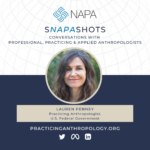2016: Tom Greaves
NAPA’s first Volunteer of the Year awardee is Tom Greaves, who has served as the coordinator for the NAPA Mentor Match program for several years. If you are planning to attend the Minneapolis meeting, come to the NAPA Business Meeting on Friday evening to help celebrate! Tom chose anthropology (initially archaeology) as a life career at age 13 by volunteering at the State Museum in Seattle. After attending the University of Washington, he went to Cornell as a student of Allan Holmberg, who profoundly shaped his applied interests.
Always an academic, Tom was able to meld doing and teaching anthropology with academic administration at various universities. He moved to Bucknell as provost, and 3 years later he ended his administrative responsibilities, re-embracing teaching and research full time as professor of anthropology. Though he became emeritus in 2011, he continues limited teaching and mentoring. Tom’s service to anthropology included editing the American Anthropologist, election as President of the SfAA, being program chair for the AAA annual meeting, chairing the AAA’s Committee for Human Rights, and service on numerous committees.
NAPA recently conducted an online interview with Tom. Here are some excerpts [from the September 2016 issue of NAPA Notes:
Tom Greaves
What drew you to anthropology and especially practice?
When I was a senior anthropology major at the U. of Washington (1963) Allan Holmberg visited from Cornell and gave a talk on the Vicos Project. I was entranced and made up my mind to do graduate training as his student at Cornell.
How long have you been a NAPA member?
I have no idea. I was a member of AAA from 1969 onwards, but when I joined NAPA as a section I don’t recall.
How did you get involved in the first place with NAPA volunteering? Is this your first volunteer activity with NAPA?
I’ve always been involved in professional service, mostly to the AAA and SfAA, serving on committees, annual meeting program chair, AA editor, etc. After my term as president of SfAA I and others, dismayed at the counterproductive undercurrent of rivalry between SfAA and NAPA, worked aggressively to diminish it. It was then that I became active in NAPA committees.
How long have you been doing the Mentor Match?
I became Mentor-Match Coordinator in March 2008, succeeding Kathi Kitner.
What is the importance of NAPA’s Mentor Match?
NAPA’s Mentor Match fulfills an unparalleled function as a source of interactive guidance over time for students of anthropology who are committed to, or just curious about, a career in applied anthropology but who find that their department faculty have little or no familiarity with applied anthropology, particularly in a non-academic setting. Sadly, this is commonplace among colleges and universities in the United States.
How many mentoring queries do you deal with?
Over the course of a year about 90 individuals contact Mentor Match for the first time. Those, plus individuals already in ongoing mentoring from the prior year generate about 225 e-mails to me in a year’s time. Typically, individuals who continue after their first inquiry are mentored for 6 to 12 months, but some, whom I treasure, have continued for several years. The rate of e-mail traffic varies with the time of year, with the heaviest volume from late spring through late summer. Depending on the time of year, e-mails generally arrive at the rate of one to six per week. I personally mentor almost all of the inquiries from undergraduates, plus those with BA degrees, and those in the first year or two of graduate study. Importantly, for more than a year, Niel Tashima (NAPA Mentor Committee Chair) has partnered with me, finding mentors for those who are professionally practicing, with a completed PhD or practicing masters degree (about 10-15 per year). Niel has a remarkably extensive personal network of potential mentors. His help has taken a major burden off of me (arranging mentors), allowing me to concentrate on those who are undergraduates, BAs, and early graduate students.
What are the most common questions/types of queries you receive?
Perhaps the most common area of concern I encounter stems from students, both undergraduate and graduate, who are strongly interested in applied, usually non-academic, careers, but who find little guidance elsewhere. That same concern is voiced by students who have a BA, are in the workforce, and now want guidance on graduate training to pursue an applied career using anthropology. We created NAPA’s Frequently Asked Questions (FAQs) resource about 3 years ago , which has sharply reduced the amount of information that needs to be transferred in the e-mails, allowing me to focus on a more personal level of guidance. Happily, the FAQ resource has now become very important to audiences well beyond Mentor Match.
Along with mentoring hundreds of new anthropologists over the years, what are some of your other contributions to applied anthropology?
My anthropology research and writing always was a mix of applied and non-applied efforts. For instance, my dissertation research in coastal Peru was a controlled comparison of four coastal haciendas in Peru, to enable a better contextual understanding of Holmberg’s Vicos, sited in a quasifeudalistic, highland hacienda, and then the most discussed example of applied anthropology. Later I was particularly active in the anthropology of rural proletarians, unionized wage laborers, and the peasant-to proletarian transition. Later still I became fascinated with various cases of Indigenous groups challenging their surrounding national states and winning (e.g., the Brazilian Kayapo; Canada’s Eastern Cree). And most recently I have analyzed and written about Indigenous intellectual property and cultural rights. I served for 4 years as the chair of the AAA’s Committee for Human Rights. The Committee, composed of remarkably committed colleagues, was very active in, especially, intervening on behalf of indigenous peoples around the world. There is a reciprocity: they are the ones who hosted, and still host, much of our anthropological work.
Do you need people to serve as mentors? If so, should they contact you?
We are always glad to know of colleagues interested in mentoring, because NAPA has various ways to mentor. And since it will soon become timely to pass my role on to another, inquiries from colleagues interested in shouldering my role are welcome. There are great pleasures in mentoring; getting appreciative letters from former advisees is a big one.




